Background Intro
Are you struggling with hair loss or thinning hair? Do you want to add volume and length to your hair but don't want to wear a full wig? Then hair toppers might be the perfect solution for you! Hair toppers, also known as hairpieces or wiglets, are a great way to boost your confidence and enhance your look. But with so many different types of hair toppers available, it can be difficult to know which one is right for you.
In this guide, we'll explore the different types of hair toppers available, their benefits and drawbacks, and how to put on each type properly.
Related: Hair Loss In Women: What Causes It And How To Solve It
What Makes Hair Toppers The Wonderful Choice For Thinning Hair?
Clip-in Hair Toppers
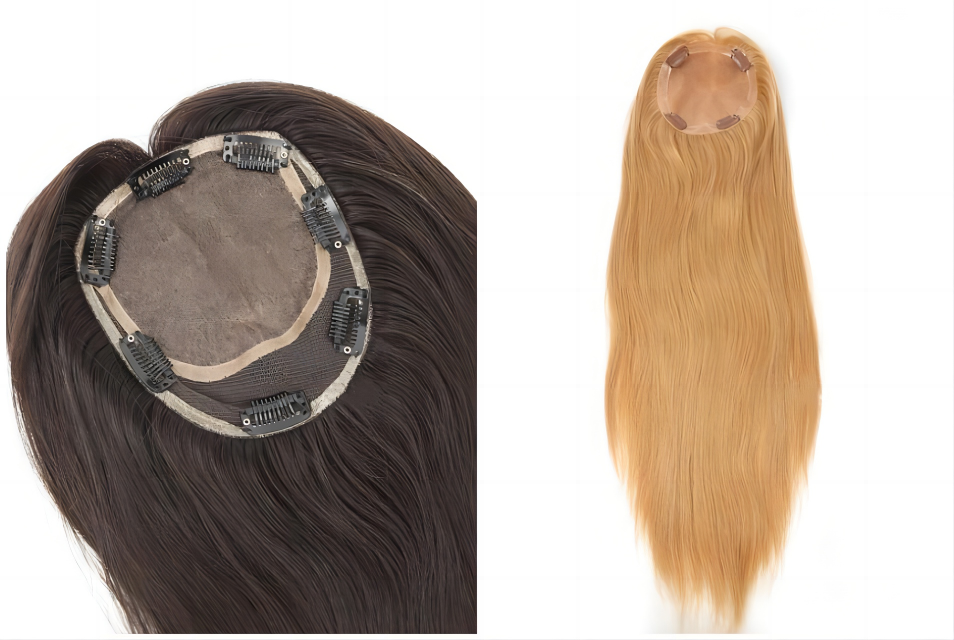
Clip-in hair toppers are the most popular and versatile type of hair topper. They come in various sizes, ranging from small pieces that cover only the crown area to larger pieces that cover the entire head. They consist of small sections of hair that are attached to a base that can be clipped onto the existing hair. They can provide coverage to a specific area of the scalp, such as the top or crown, and can be removed easily whenever desired.
Advantages:
Versatility: You can use clip-in hair toppers to create different hairstyles and looks, from adding volume to creating updos or ponytails.
Easy to Use: These toppers are easy to install and remove, making them a convenient choice for everyday wear or special occasions.
Affordability: Clip-in hair toppers are generally more affordable than other types of hair toppers.
Low Maintenance: These toppers require minimal maintenance compared to other types of hair toppers.
Disadvantages:
Limited coverage: Clip-in hair toppers may not provide full coverage for individuals experiencing significant hair loss.
May not be suitable for all hair types: These toppers may not work well with certain hair types, such as extremely curly or coarse hair.
May shift or move: These toppers may shift or move during physical activity or when exposed to wind or other environmental factors.
May require frequent adjustments: Clip-in hair toppers may need to be adjusted frequently to ensure they remain securely in place.
Limited durability: These toppers may not last as long as other types of hair replacement systems.
Who is Clip-in Hair Toppers Best Suited for?
Clip-in toppers are great for those who want a quick and easy way to add volume and length to their hair. They are suited for people with mild to moderate hair loss, or for those who want to add volume and thickness to their hair. They are also ideal for people who want a removable and affordable hair restoration option.
How to Put on Clip-in Hair Toppers?

Start with clean, dry hair. Brush your hair thoroughly to remove any tangles and make sure it's smooth.
Open the clips on the hair topper. The clips should be positioned along the underside of the topper, usually in a U-shape pattern.
Place the topper on top of your head where you want to add volume or cover hair loss. Gently press down on the base of the topper to secure it in place.
Snap the clips closed by pressing down on each side until you hear a click. Make sure the clips are firmly attached to your natural hair, but not too tight that they cause discomfort.
Blend the topper with your natural hair. Use a comb or brush to gently blend the topper with your own hair, so that it looks natural and seamless.
Style as desired. You can style your hair as you normally would with the topper in place.
It may take a few tries to get the placement and attachment just right, so don't get discouraged if it doesn't look perfect at first. With practice, you'll become more comfortable putting on clip-in hair toppers and achieving the look you desire.
Tape-In Hair Toppers
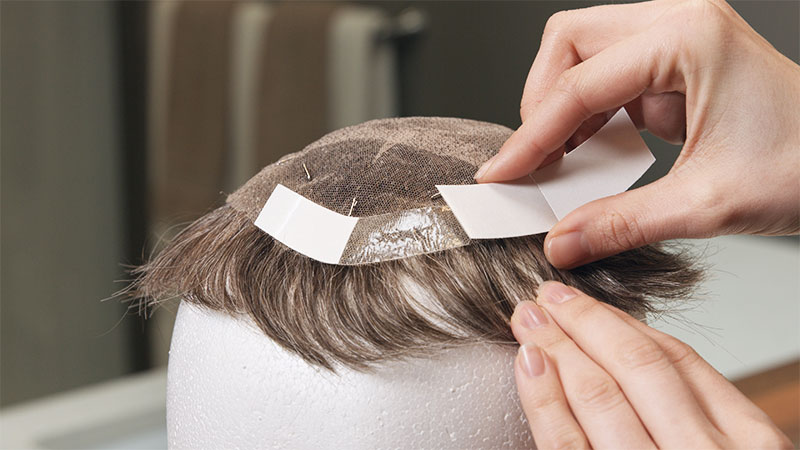
Tape-in hair toppers are another popular type of hair topper. They are attached to your hair using double-sided tape, which is applied to the base of the hairpiece and then layered with a section of your own hair. Tape-in hair toppers are semi-permanent hair extension pieces attached to your hair using tape-ins. They are designed to be worn for several weeks at a time and can be washed and styled like your natural hair.
Advantages:
Natural-Looking: Tape-in hair toppers blend seamlessly with your natural hair, creating a natural-looking appearance.
Comfortable: These toppers are lightweight and comfortable to wear, making them ideal for everyday use.
Low Maintenance: These toppers require less maintenance, as they can be washed and styled like your natural hair.
Versatility: You can create various hairstyles with tape-in hair toppers, like braids and twists.
Disadvantages:
Limited durability: Tape-in toppers can't stay on for as long as other types of hair replacement systems.
May require professional installation: Achieving a seamless and natural look with tape-in hair toppers may require some skills.
May not be suitable for all hair types: Tape-in hair toppers cannot match all hair types, such as coiled hair.
May cause damage to natural hair: The adhesive used to attach tape-in hair toppers to your natural hair can cause damage.
May need frequent maintenance: Tape-in hair toppers may need to be adjusted and repositioned frequently.
Who is Tape-In Hair Toppers Best Suited for?
Tape-in toppers are great for those who want a semi-permanent solution to their hair loss or thinning hair. They are easy to apply and can be worn for several weeks at a time, making them a convenient choice for those who don't want to constantly remove and reapply their hairpiece. They are also good for anyone who wants to style their hair with ease.
How to Put on Tape-In Hair Toppers?
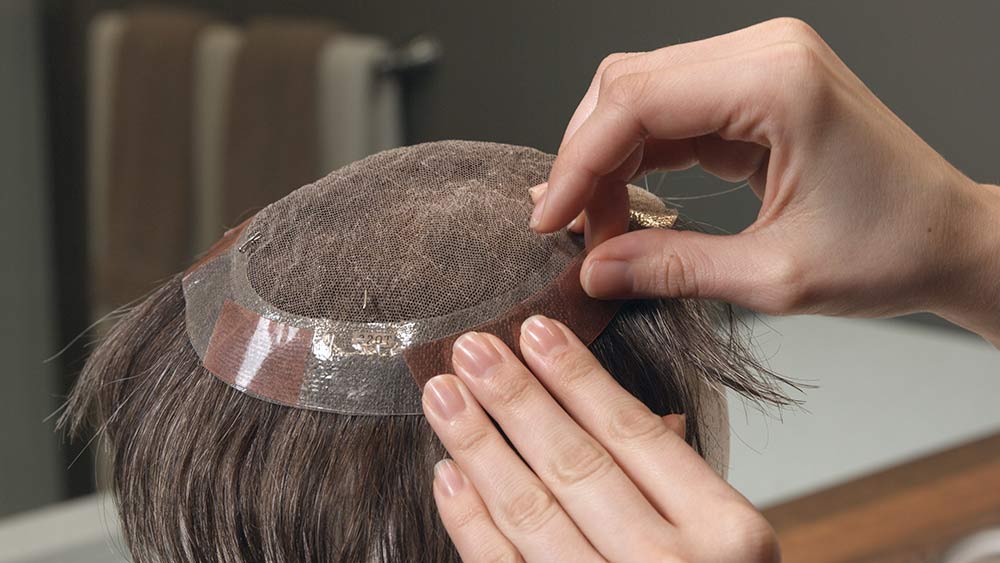
Make sure your hair is clean, dry, and free of any tangles or knots. Comb or brush it straight, and part it where you want the hair topper to sit.
Using a clip or hair tie, pull back the top section of your hair where the hair topper will be placed.
Take the hair topper and remove the protective backing from the adhesive tape.
Place the hair topper onto your head, aligning it with your hairline and ensuring that it is centered.
Gently press down on the hair topper to secure it in place. Smooth out any bumps or wrinkles and secure against your scalp.
Release the top section of your hair and blend it with the hair topper. You may need to trim or layer the hair topper to achieve a seamless blend.
Repeat the process for any additional hair toppers. If you're using multiple hair toppers, be sure to space them out evenly.
Style your hair as desired. You can use heat styling tools like curling irons or straighteners to create different looks with your new hair topper.
Remember, proper care and maintenance are key to keeping your hair topper looking great. Avoid using harsh chemicals or products on the hair topper, and be gentle when brushing or styling it.
Wefted Hair Toppers
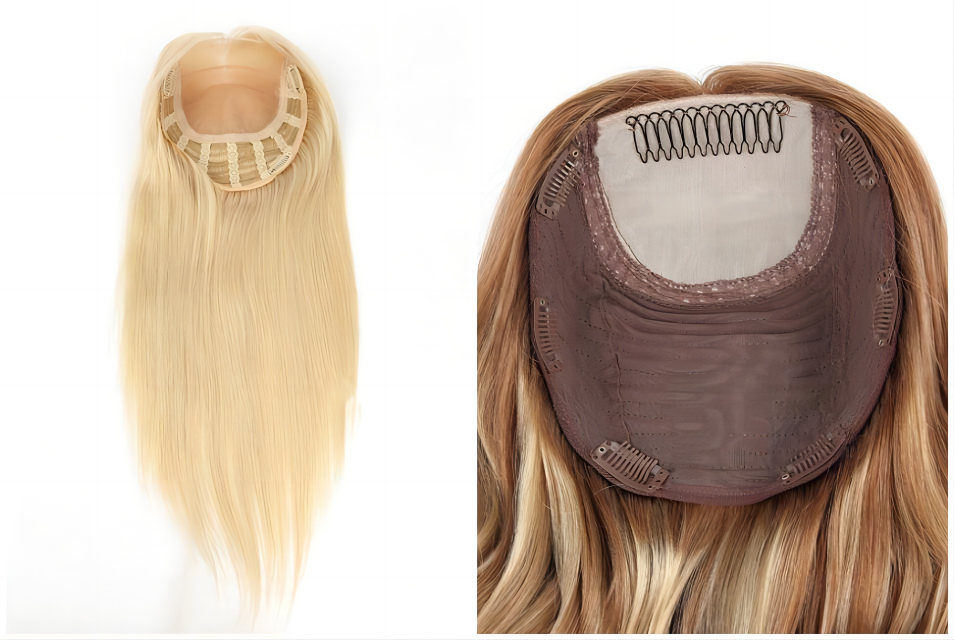
Wefted hair toppers are a natural hair extension that offers an all-over solution for baldness or moderate to severe hair loss. They are made by sewing hair extensions onto a weft, which is a long strip of fabric that can be attached to your natural hair. These hairpieces are sewn into a portion of your hair to provide full coverage.
Advantages:
Natural looking: Weft hair toppers are designed to look and feel like your natural hair, providing a seamless and natural appearance.
Versatile: These toppers can be styled in a variety of ways, giving you the freedom to create the look you want.
Comfortable: Weft hair toppers are lightweight and breathable, making them comfortable to wear for extended periods of time.
Easy to maintain: These require minimal maintenance and can be easily washed and styled just like your natural hair.
Non-damaging: Weft hair toppers do not require any adhesive or glue, which means they won't damage your natural hair or scalp.
Disadvantages:
Limited durability: Weft hair toppers are of average durability, especially if they are exposed to daily wear and tear.
May require professional installation: While these toppers can be installed at home, achieving a seamless look require more tricks.
May not be suitable for all hair types: Weft hair toppers cannot be adapted to every hair type.
Limited coverage: These toppers may not provide full coverage for individuals experiencing significant hair loss.
May shift or move: Weft hair toppers may shift or move during physical activity or when exposed to wind or other environmental factors.
Who is Wefted Hair Toppers Best Suited for?
Wefted hair toppers are best suited for individuals who are experiencing hair thinning or hair loss on the top of their head, known as androgenetic alopecia. Wefted hair toppers can be used to add volume and coverage to the affected areas, making the hair look fuller and thicker. They are also a good option for those who do not want to commit to a full wig but still want to achieve a natural-looking hairstyle.
How to Put on Wefted Hair Toppers?

Before you put on the hairpiece, brush your natural hair and create a base for the hairpiece to sit on. This will help ensure that it fits comfortably and looks natural.
Place the wefted hair topper on your head so that the front edge is aligned with your natural hairline. Then, gently slide the hairpiece back so that it sits comfortably on your scalp.
Secure the hairpiece in place. Begin by attaching the front clips first before moving on to the back clips. Make sure the clips are tightly secured.
Adjust its position as necessary to ensure that it looks natural and blends well with your own hair.
Style it as desired using heat tools or hair products. Remember to be gentle when styling to prevent damage.
It's essential to take good care of your wefted hair topper to keep it looking its best. Regularly washing it with a mild shampoo and conditioner, storing it properly when not in use, and avoiding excessive heat styling can all help maintain the wig's quality and appearance.
Partial Hairpieces
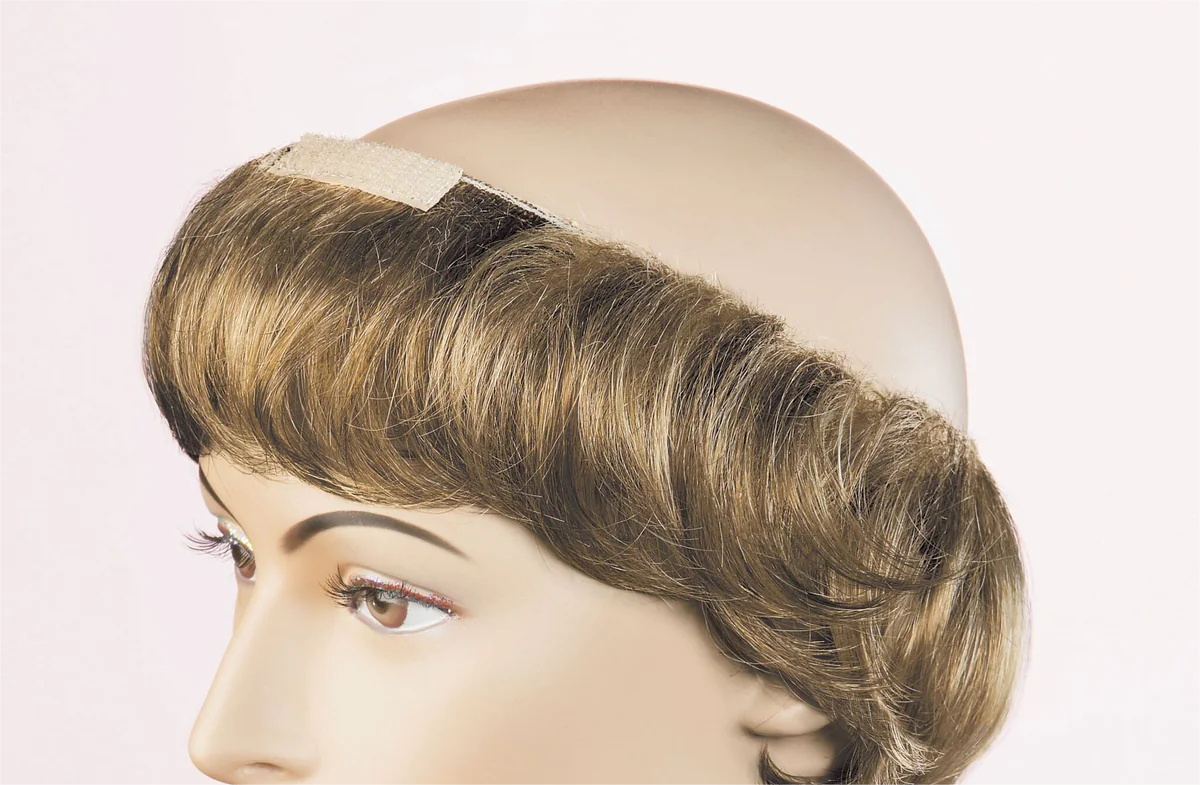
Partial hairpieces are hair toppers that cover a larger area of the scalp than clip-in hair toppers. They are usually designed to cover the crown or top of the head, and can be attached to the existing hair using clips, tapes, or adhesives. Partial hairpieces can be made of human hair, synthetic hair, or a combination of the two, and are available in different colors, textures, and lengths.
Advantages:
Natural-looking results: Partial hairpieces can be made from real human hair or high-quality synthetic fibers that look and feel like natural hair. Versatility: These toppers come in a variety of sizes, colors, and textures, allowing you to choose one that meets your unique needs.
Easy maintenance: Partial hairpieces require minimal upkeep and can be washed, styled, and maintained like your natural hair.
Non-surgical solution: These toppers do not require any incisions or anesthesia, which can minimize the risk of complications or side effects.
Affordability: They can be purchased off-the-shelf or custom-made to fit your specific needs and budget.
Disadvantages:
High Maintenance: Partial hairpieces need to be washed and styled regularly to maintain their appearance and prevent damage.
May be a little uncomfortable: The weight of the hairpiece can cause tension on the scalp, which may lead to headaches or discomfort.
Low Durability: Partial hairpieces are not as durable as natural hair and may need to be replaced more frequently.
Limited styling options: It may not be possible to achieve certain hairstyles or updos with a hairpiece.
Who is Partial Hairpieces Best Suited for?
Partial hairpieces are best suited for people with moderate to severe hair loss, or for those who want a more permanent hair restoration option. They are also ideal for people who want a hair topper that can be attached using different methods.
How to Put on Partial Hairpieces?
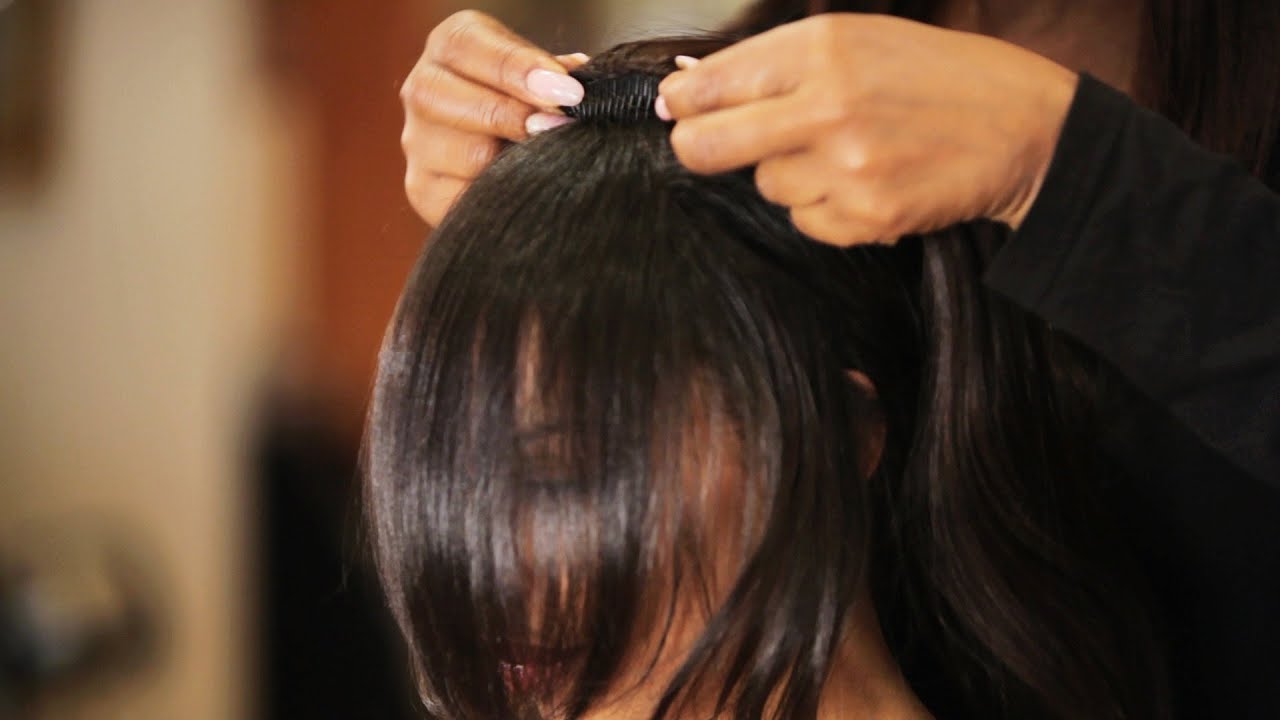
If you have any hair in the area where you will be attaching the hairpiece, make sure it is clean and free of product buildup. You may want to tease your hair at the roots to create a better base for the hairpiece to clip onto.
Place the hairpiece over the area of your head where you want to add volume or coverage. Make sure it is centered and lined up with your natural part if you have one.
Use these clips to secure the hairpiece to your natural hair. Start with the front clip and work your way back, making sure each clip is securely attached.
Once the hairpiece is attached, use a brush or comb to blend it with your natural hair. You can also style the hairpiece using heat tools like curling irons or straighteners to match your desired look.
Finally, make any necessary adjustments and finish with hairspray or other styling products to hold the hairpiece in place.
It's important to remember that everyone's hair and hairpieces are different, so it may take some trial and error to find the best method for putting on your particular hair topper.
Integration Hair Toppers

Integration hair toppers are a more permanent solution to hair loss and are ideal for those who want a more seamless and natural-looking solution. They are custom-made to fit your head and scalp and are designed to blend seamlessly with your natural hair. Integration hair toppers are attached to your natural hair using a variety of methods, including weaving, braiding, or bonding. They are available in different types of hair, including human hair, synthetic fiber, or a combination of both. If you want a more natural-looking solution, consider investing in high-quality human hair.
Advantages:
Natural-looking: Integration hair toppers are designed to blend seamlessly with your natural hair.
Versatility: These toppers can be styled in a variety of ways, just like your natural hair. You can curl or straighten to suit your desired look.
Comfortable: Integration hair toppers are lightweight and breathable, making them comfortable to wear all day long.
Easy to maintain: Integration hair toppers require minimal maintenance and can be washed, dried, and styled just like your natural hair.
Disadvantages:
High Maintenance: Integration hair toppers require regular maintenance and upkeep to keep them looking their best.
May be a little uncomfortable: They may also cause itching, sweating, or irritation on the scalp.
Low Durability: Integration hair toppers can be vulnerable to damage from heat, chemicals, and other environmental factors.
High Cost: Integration hair toppers can be expensive if they are made from high-quality materials or customized to fit your specific needs.
Who is Full Integration Systems Best Suited for?
Full integration systems are best suited for people with total hair loss, or for those who want a hair restoration option that looks completely natural. They are also ideal for people who want a hair topper that can be customized to match their desired hair density, color, texture, and length.
How to Put on Integration Hair Toppers?
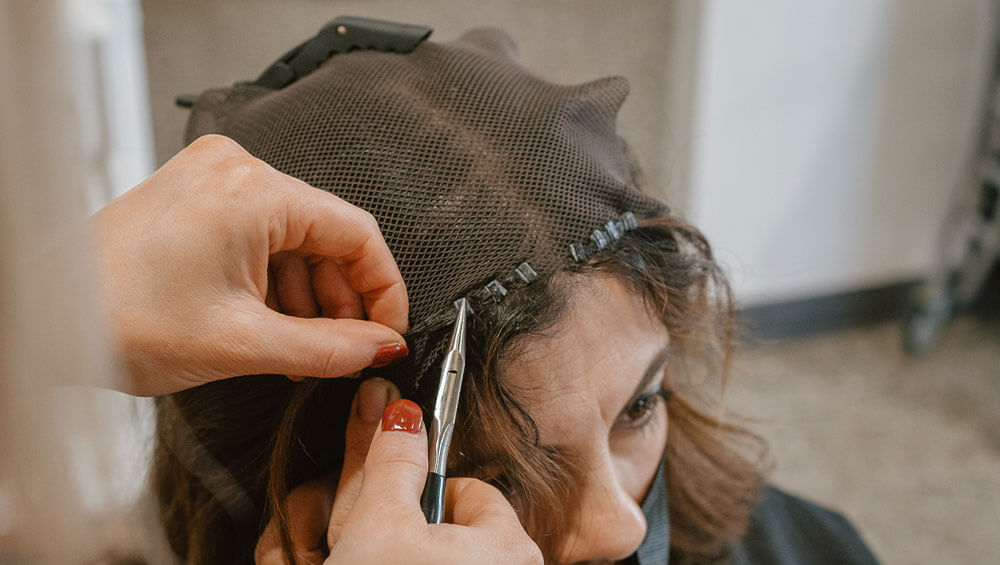
First, make sure that your own hair is clean and dry before putting on the topper.
Section your natural hair by creating a horizontal parting at the crown area of your head. Clip the top section of your hair out of the way so that you can access the bottom layers.
Take the integration hair topper and position it over the area where you created the parting.
Attach the front clips of the topper to your natural hair, starting from one side and moving to the other. Then, attach the back clips of the topper to your hair, making sure that it feels secure.
Once the topper is attached, use a comb or brush to blend your natural hair over the topper.
Release the top section of your hair and blend it with the topper as needed. You can also style your hair and the topper together using hot tools like curling irons or straighteners.
Finally, check that the topper feels comfortable and secure. If it feels loose or unstable, adjust the clips or positioning as needed.
Remember, every integration hair topper is different, and there may be specific instructions that come with your particular product. Following those instructions can help ensure that you get the best results.
What is the Best Hair Topper for Thinning Hair & Hair Loss?
There are many different types of hair toppers for those with thinning hair or hair loss, and the best option will depend on your individual needs and preferences. You can refer to the following five factors to make your choice.
Material
Human hair toppers are considered the best option for a natural-looking appearance because they are made from real human hair, which closely mimics the look and texture of natural hair. However, synthetic hair toppers have come a long way in recent years and can also provide a very realistic look, at a lower price point.
Base type
The base of the hair topper is the part that attaches to your scalp and provides coverage for the areas where you are experiencing hair loss. There are different base types such as monofilament, lace, and silk. Monofilament bases are usually the most natural-looking because they feature a sheer material that appears like skin when placed against the scalp. Lace bases offer good breathability and provide a natural-looking hairline, while silk bases are highly durable and can be more comfortable to wear.
Size and shape
Hair toppers come in different sizes and shapes to fit different areas of the head. It's essential to choose a size and shape that matches your hair loss pattern so that it looks natural and blends well with your remaining hair.
Color and texture
When choosing a hair topper, it's important to select one that matches your natural hair color and texture as closely as possible to achieve a seamless blend. If you're not sure which shade to choose, consider bringing a sample of your hair to a specialist who can help match the color for you.
Quality and durability
A high-quality hair topper will typically last longer and retain its appearance better, making it a better value in the long run. Consider investing in a hair topper made from high-quality materials and constructed with care and attention to detail to ensure that it lasts as long as possible and maintains its natural look.
Related: The Most Comprehensive Guide For Hair Toppers 101
Final Thoughts
Hair toppers are a perfect solution to hair loss and thinning hair. They provide a natural-looking and convenient solution that you can customize to your preferences. Be sure to consider factors such as density, length, color, texture, style, and material before making a purchasing decision. With the right hair topper, you can achieve a natural-looking, fuller head of hair that will leave you feeling confident and beautiful.
Images credit: Google, Pinterest, YouTube.
